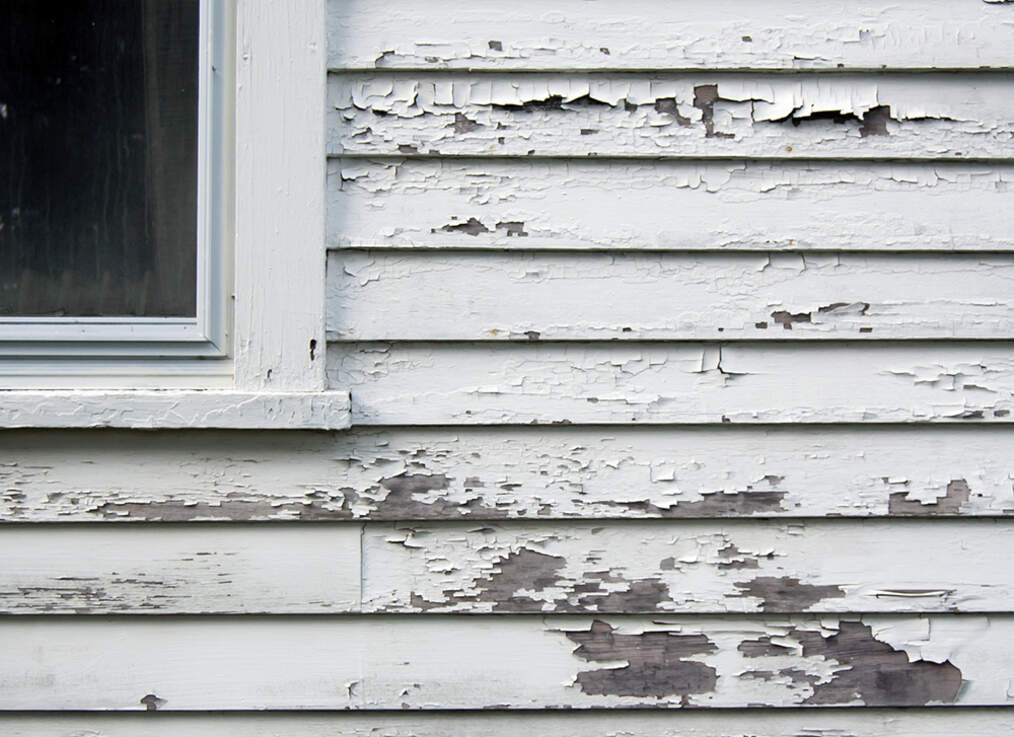Peeling paint on the outside of your home is hard to ignore. Whether it’s flaking around windows, bubbling along stucco walls, or patches coming off in sheets, the effect is the same: it drags down curb appeal and signals a problem beneath the surface.
But here’s the thing—peeling paint is almost never just cosmetic. It’s a red flag. In Southwest Florida especially, where homes are exposed to salt air, humidity, and UV rays year-round, paint failure often points to deeper issues like trapped moisture, poor prep work, or low-quality materials.
So if you’ve noticed sections of your exterior paint coming loose, don’t reach for the nearest roller or touch-up kit. Quick fixes won’t solve the underlying issue and often make the problem worse. Understanding how to fix peeling paint on exterior walls the right way means addressing what’s causing the failure, not just hiding the damage.
In the sections ahead, we’ll walk through the most common causes, why DIY touch-ups usually don’t hold up, and how professional painters approach this kind of repair for long-term protection.
Understand What Causes Exterior Paint to Peel
Before fixing peeling paint the right way, it’s important to understand why it’s happening in the first place. Many homeowners assume paint failure is just due to age, but in reality, it’s often the result of improper application, poor surface prep, or environmental exposure—especially in coastal areas like Fort Myers and Naples.
If the root cause isn’t addressed, any exterior repainting—no matter how clean it looks at first—will eventually peel again.
Common causes of peeling exterior paint include:
- Moisture intrusion: Rainwater, humidity, or condensation behind siding and stucco can break the bond between the paint and surface, causing it to blister and peel.
- UV damage: In Florida’s sun-intense climate, prolonged exposure can dry out and crack exterior paint, especially if low-quality products were used.
- Improper surface preparation: If the surface wasn’t cleaned, sanded, or primed correctly before painting, the new paint will struggle to adhere and can peel prematurely.
- Inferior paint or mismatched coatings: Using interior-grade paint or applying latex over oil-based finishes without proper prep can lead to poor adhesion.
- Painting in bad conditions: Painting on a damp, dirty, or overheated surface can cause bubbling and early failure, even with premium paint.
Professional painters don’t just repaint over the damage—they diagnose and correct what caused the peeling in the first place. That’s why any long-term solution starts with a professional assessment of the affected surfaces.
Why DIY Scraping and Repainting Isn’t Enough
At first glance, peeling exterior paint might look like an easy fix. A quick scrape, a fresh coat of paint, and you’re done—right? Unfortunately, that approach rarely works. In fact, painting over flaking or poorly prepped surfaces often makes the problem worse, leading to even faster failure and more expensive repairs down the road.
Fixing peeling paint the right way requires more than just a trip to the hardware store. It demands technical skill, surface knowledge, and the kind of prep work most DIY methods skip entirely.
Here’s why DIY solutions often fall short:
- Surface prep is rarely thorough enough: Without commercial-grade tools or experience, homeowners often miss areas that need deeper sanding, patching, or priming.
- Hidden moisture isn’t addressed: If there’s water damage beneath the surface, painting over it only traps the problem and causes new peeling in weeks or months.
- Wrong product choices: Many DIYers don’t realize that coastal climates require specific exterior paints and primers. Using the wrong product, or applying it at the wrong time of day can sabotage the finish.
- Inconsistent results: Blending new paint with existing color rarely works perfectly. Without the right technique, touch-ups can look obvious and reduce curb appeal.
- No warranty or accountability: If a DIY job peels again—or damages your siding—there’s no warranty, no service agreement, and no one to call for help.
When it comes to fixing the peeling paint on exterior walls, there’s simply no substitute for professional prep and application. A licensed contractor doesn’t just paint—they restore, protect, and finish your exterior for long-term performance.
How Professionals Fix Peeling Exterior Paint Correctly
Fixing peeling paint the right way isn’t just about appearances—it’s about creating a solid foundation that protects your home for years. That’s why professional painting contractors follow a multi-step process that goes well beyond scraping and repainting.
Unlike patchy DIY methods, a licensed and insured painting contractor will inspect, prep, and apply coatings with precision, using products and techniques suited for your home’s surface and climate.
Here’s what a proper professional process looks like:
- Full surface evaluation: Before starting any repair, a contractor will inspect the wall for signs of moisture, cracks, mildew, or material failure. This ensures the issue isn’t just paint-deep.
- Power washing: Professional-grade pressure washing removes dirt, chalky residue, and loose paint so the surface is clean and ready for prep.
- Scraping and sanding: All flaking or blistering paint is removed down to a solid surface. Then, any edges are feather-sanded smooth to avoid visible transitions in the new finish.
- Spot priming bare areas: Exposed surfaces are primed using climate-appropriate primers that ensure proper adhesion and protection. In Florida, this often includes mildew-resistant or water-blocking primers.
- Applying the right exterior paint: Once the surface is dry and prepped, high-quality exterior paint is applied in even coats—often two—to deliver long-term color retention and weather resistance.
- Careful timing: Experienced painters won’t rush the job. They watch the forecast, paint at the right time of day, and allow proper drying time between coats for optimal performance.
This process is how professionals ensure the fix isn’t temporary. It’s also why painting contractors who follow best practices offer workmanship warranties—because their process is built to last.
Protecting Your Investment After Repainting
Once peeling paint has been properly repaired and a fresh coat has been professionally applied, the job isn’t over. Like any part of your home’s exterior, paint needs basic upkeep to maintain its protection and appearance. Fortunately, most of this maintenance is simple—and with the right care, a high-quality paint job can last many years.
Professional painters not only correct the peeling but also help set homeowners up for long-term success. That includes advice on seasonal maintenance and signs to watch for over time.
Here are a few ways to protect your freshly repainted exterior:
- Rinse surfaces annually: Use a low-pressure hose or soft-wash service to remove dirt, mildew, and salt buildup—especially in coastal neighborhoods.
- Inspect high-exposure areas regularly: Window sills, fascia boards, and shaded corners are common places where moisture can cause early paint failure.
- Keep gutters and downspouts clear: Overflowing gutters can lead to water intrusion behind paint and siding, especially near rooflines.
- Address small issues early: If you notice hairline cracks or tiny blisters, don’t wait. A quick inspection can catch problems before they spread.
- Work with a contractor that offers follow-up: Many reputable painters offer optional maintenance check-ins or warranties that include minor touch-ups.
Professional painting isn’t just about application—it’s also about long-term protection. Taking a little time each year to maintain your exterior can extend the life of your paint and preserve your home’s value.
Don’t Just Cover Up Peeling Paint—Fix It the Right Way
Peeling exterior paint isn’t just a maintenance issue—it’s a warning sign that your home’s protective layer is failing. Whether caused by moisture, sun exposure, or poor prep from a previous job, the solution isn’t a quick touch-up. It’s a strategic, professional fix that starts with identifying the cause and ends with a durable, climate-ready finish.
By working with a licensed and insured painting contractor, you get more than a clean look. You get long-term protection, expert surface prep, and a finish built to last in Florida’s demanding environment. That kind of quality doesn’t come in a can—it comes from experience.
If you’re dealing with bubbling, flaking, or fading paint on your home’s exterior, don’t wait for it to spread. A professional evaluation now can save you from more extensive repairs later and restore both the beauty and protection of your home.
Want to understand what’s causing paint failure on your exterior walls? Talk with a team that’s seen—and fixed—it all.











